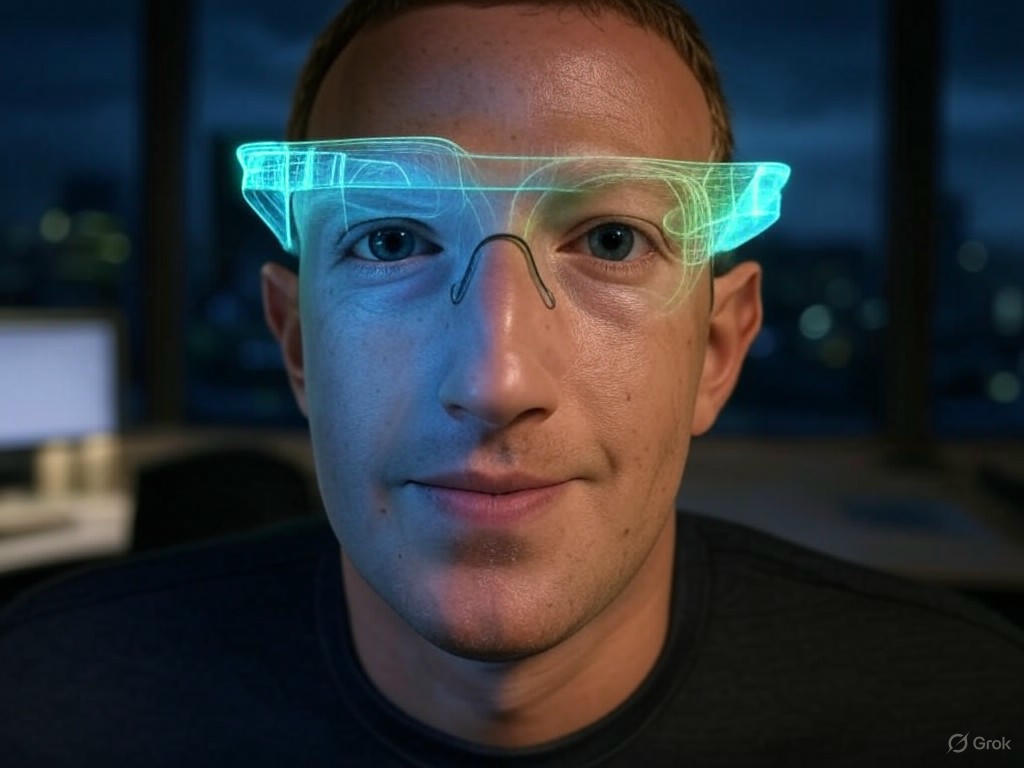
AI Vision: Mark Zuckerberg’s Strategy for Meta’s Future
Meta Description
Mark Zuckerberg is doubling down on generative AI innovation, betting Meta’s future on open-source development and advanced AI tools to target a staggering $1.4 trillion in revenue by 2035. This strategy highlights Meta’s shift from social media dominance to AI leadership, blending cutting-edge models like Llama with everyday devices for transformative user experiences.
The Dawn of Meta’s Generative AI Revolution
Imagine a world where AI isn’t just a tool—it’s woven into every aspect of our digital lives. That’s exactly what Mark Zuckerberg envisions for Meta. In 2025, he unveiled a bold overhaul, turning Meta from a social media giant into an AI powerhouse with upgrades to the Meta AI assistant, new versions of the Llama language model, and AI-infused devices like the Ray-Ban Meta smart glasses.
This shift is backed by massive investments—up to $65 billion annually in AI infrastructure—reflecting Zuckerberg’s confidence in generative AI as the key to unlocking Meta’s next chapter. Have you ever wondered how these investments could reshape how we create, connect, and innovate? It’s a high-stakes play that’s drawing eyes across the tech world.
From Metaverse Dreams to Generative AI Realities
Meta’s early bet on the metaverse was ambitious, pouring in $10 billion to build virtual worlds, but adoption lagged, leaving Zuckerberg to pivot. By 2024, he realized that true breakthroughs required diving deep into generative AI and artificial general intelligence (AGI), putting Meta in the ring with powerhouses like OpenAI and Google DeepMind.
This strategic turn isn’t just about survival; it’s about redefining digital experiences. For instance, generative AI could one day help design personalized virtual environments or generate content on the fly, making the metaverse more accessible and engaging. What if your social media feed could evolve into an intelligent assistant that anticipates your needs?
Building Blocks of Meta’s Generative AI Ecosystem
At the heart of Zuckerberg’s plan is a robust ecosystem designed to make generative AI seamless and powerful. The Meta AI assistant now spans devices, offering text, voice, and image interactions that feel almost intuitive.
- Generative AI Assistant: This standalone app integrates across platforms, turning everyday tasks into effortless experiences by generating real-time responses and creative outputs.
- Llama Models: These open-source language models are evolving rapidly, powering tools that enhance everything from chatbots to content creation, and they’re a cornerstone of Meta’s generative AI strategy.
- Ray-Ban Meta Glasses: Picture walking down the street while your glasses use generative AI to describe what you’re seeing or suggest ideas based on your surroundings—it’s a glimpse into the future of wearable tech.
- Open-Source Philosophy: Meta’s commitment to open innovation sets it apart, allowing developers globally to build on these tools, fostering a collaborative environment that accelerates generative AI adoption.
The Edge of Open-Source Generative AI
During the 2025 LlamaCon event, Zuckerberg doubled down on this open approach, challenging closed systems like those from OpenAI. It’s not just about competition; it’s about democratizing generative AI so that creators and businesses can customize it for their needs.
For example, a small startup could use Llama models to develop affordable AI solutions without starting from scratch. This openness could spark widespread innovation, but it raises questions: Will it lead to safer, more ethical AI, or introduce new risks?
Investing Big in the Generative AI Future
Zuckerberg isn’t holding back, with Meta ramping up capital expenditures to $60–65 billion annually for AI infrastructure—a jump from $23 billion in 2022. He sees this as a decade-long gamble, where generative AI could revolutionize industries beyond advertising, from automated software development to digital agents that handle complex tasks.
- Generative AI Revenue Projections: Meta eyes $2-3 billion in generative AI revenue by 2025, potentially exploding to $1.4 trillion by 2035 as new opportunities emerge.
- Market Pressures: Stock fluctuations show investor jitters, with worries about regulatory hurdles and whether these investments will pay off in the short term.
- Ad-Centric Model: For now, generative AI enhancements are boosting Meta’s core advertising business, but the real gold might lie in diversifying into AI services.
This scale of investment highlights how generative AI could turn Meta into a tech titan, but it’s not without risks. Think about it: If AI agents start writing code autonomously, could that free up human developers for more creative work?
Cutting-Edge Innovations in Generative AI
2025 brought a flurry of launches that underscore Meta’s generative AI ambitions. The Meta AI app, powered by Llama 4, lets users generate text, images, and voice responses across devices, making AI interaction feel second nature.
- It seamlessly blends into smartphones and glasses, offering features like real-time image editing or conversational storytelling.
- The upgraded Ray-Ban glasses now use generative AI for on-the-spot visual analysis, turning them into personal guides for everything from travel to daily tasks.
- Tools like the Edits video app leverage generative AI to simplify content creation, allowing users to generate effects or scripts with minimal effort.
Generative AI’s Role in Shaping the Workforce
Zuckerberg predicts that by late 2025, generative AI will handle mid-level engineering tasks at Meta, streamlining workflows and boosting efficiency. In the long run, it could mean AI writing most software, freeing humans for strategic thinking and innovation.
Consider a scenario where a developer uses generative AI to prototype an app in minutes—what could that mean for industries like gaming or education? It’s exciting, but it also prompts us to think about job evolution and the need for new skills.
Navigating Challenges in the Generative AI Landscape
While Meta’s generative AI push is thrilling, it’s fraught with obstacles that could slow progress. Regulatory scrutiny is mounting, with concerns over data privacy, ethical AI use, and potential copyright issues.
- Monetization gaps: Meta trails competitors like Google in turning generative AI into direct revenue streams, still leaning heavily on ads.
- Investor doubts: That $65 billion annual spend is raising eyebrows, with market volatility reflecting uncertainty about returns.
To put it in perspective, here’s a quick comparison of how major players approach generative AI:
| Company | AI Model | Business Model | Open Source? |
|---|---|---|---|
| Meta | Llama | Ad-based with open platforms | Yes |
| OpenAI | GPT-4 | Subscriptions and APIs | No |
| Gemini | Integrated into search and cloud | No |
Balancing the Pros and Cons of This Generative AI Strategy
- Pros:
- It speeds up global innovation by making generative AI tools widely accessible, as seen in Meta’s open-source initiatives.
- Generative AI enhances user engagement on platforms like Instagram and Facebook, creating more personalized and dynamic content.
- With its vast resources, Meta can rapidly scale generative AI breakthroughs, potentially leading to mainstream applications that benefit everyone.
- Cons:
- The hefty investments in generative AI come with unclear short-term returns, putting financial pressure on the company.
- Reliance on advertising for monetization limits flexibility compared to rivals with diverse models.
- Increased regulatory risks around generative AI ethics could lead to setbacks or public backlash.
Still, the potential outweighs the pitfalls for many. How might generative AI change your daily routine, from brainstorming ideas to automating tedious chores?
Envisioning a $1.4 Trillion Generative AI Horizon
Looking ahead, Zuckerberg’s strategy positions Meta as a pioneer in generative AI, aiming to capture a huge slice of the projected $1.4 trillion market by 2035. Through open innovation and deep integration into hardware and software, Meta could redefine how we interact with technology.
Of course, success hinges on overcoming challenges like ethical concerns and competition. But if Meta plays its cards right, generative AI could help build a more connected, efficient world—one where AI enhances human creativity rather than replacing it.
Wrapping Up: A Bold Bet on the Future
Mark Zuckerberg’s generative AI vision for Meta is as ambitious as it gets, blending open-source collaboration with practical innovations to shape the digital landscape. Whether it leads to world-changing advancements or serves as a cautionary tale, it’s a strategy worth watching closely.
As you reflect on this, what are your thoughts on Meta’s approach? Could generative AI truly revolutionize your world? Feel free to share your insights in the comments, explore more on our site about AI trends, or subscribe for updates on the latest tech developments.
References
- Seeking Alpha. “Meta Q1 Earnings: Solid AI Strategy, Huge CapEx Guide – Maintain Buy.” Link
- Meta AI. “About Meta AI.” Link
- AInvest. “Meta’s AI Ambitions: A Strategic Gamble.” Link
- Digital Defynd. “Pros and Cons of Meta AI.” Link
- Marketing AI Institute. “The AI Show Episode 141.” Link
- OpenTools. “Meta’s Generative AI Ambitions: A $1.4 Trillion Vision by 2035.” Link
- YouTube. “Mark Zuckerberg on AI and Meta’s Future.” Link
- The Daily Star. “LlamaCon 2025: Meta Challenges OpenAI with Open-Source AI Vision.” Link
generative AI, Mark Zuckerberg, Meta AI strategy, Llama models, open-source AI, AI innovation, Meta’s future, artificial intelligence vision, AI revenue projections, metaverse and AI





